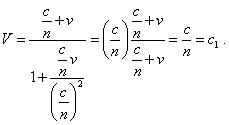SELF |
2 |
S.B. Karavashkin and O.N. Karavashkina |
|
|
|
The same with the Fizeau's experiment.
If noting that Mandelschtam was an unconcealed and insistent relativist, the positive result of Fizeau's experiment is doubtless. Thus the experiments to which Einstein referred could not justify his renunciation of the aether, as well as it was inadmissible to use only partially the relativity principle introduced by Mach and to ignore the experimental corroboration of the law by experience. However Einstein used this trick not only in introducing his postulates but in developing the whole his theory. He not only used it but has set this tone to all the followers of relativism. This is corroborated by many facts. In particular, consider briefly the Fresnel's drag factor by way of relativistic addition of velocities. As Mandelschtam stated above, according to the relativistic conception, the 'drag factor' follows from the simple relativistic summing the velocities. But to make the velocities addition possible, it is necessary, the source and observer to belong to the mutually moving reference frames. In the Fizeau experiment both the reference frames of the source and observer do not move relatively each other. So, if the light was not dragged by the medium, the velocity of water in the tube cannot affect the velocity of light propagation. Do the relativists know it? Undoubtedly. Here is what Mandelschtam writes of it:
|
|
| (1) | |
We possibly could consider to reject the Galilee's transform, should we have more solid grounds than simple juggling in summing the relativistic velocities made by the relativists. To clear the issue, let us see the standard derivation of such 'summing' presented by V. Pauli in his book "The theory of Relativity". First Pauli, conventionally for SR, obtains the formulas for the velocities addition in free space for the reference frame K ' moving relatively the frame K with the velocity v along the axis x . With it he obtains the known expression |
|
|
(2) |
Further, "supposing u'x= u ' = c/n ; ux = u = V and using (2), we yield |
|
|
(3) |
[Pauli: 12, chapter 1, item 6, p. 33- 34]. We can see that even Mandelschtam took the light velocity in a medium equal to c1 = c/n , while in this derivation only u'x but not c in the denominator has been transformed in order to account the medium! This means, the substitution was made only partially. If we transform (2) correctly, and given the light velocity varying in the medium, we will yield |
|
|
(4) |
We see from (4) that with the correct operation, the light velocity in the stationary and moving reference frames remains constant, and not approximately but strong. This result is quite regular in the view of postulating that the light velocity is independent of the reference frame, and this fully coincides with the above Mandelschtam's computation that showed Einstein's (not Mach's!) relativity principle fully contradicting the Fizeau's experimental results. Thus, we have to reject not the Galilee's transform but relativity principle. |
|


